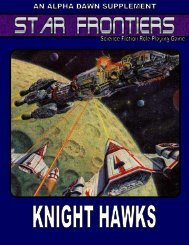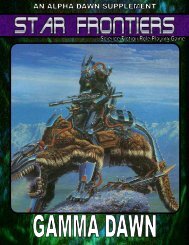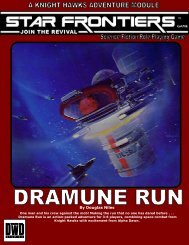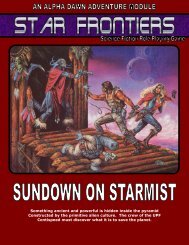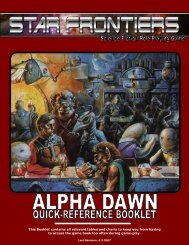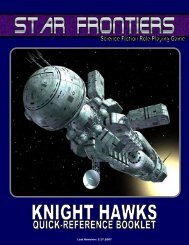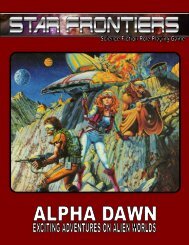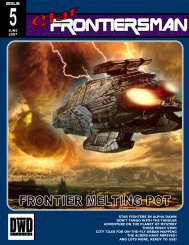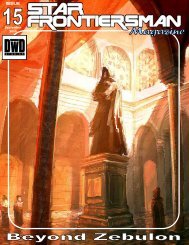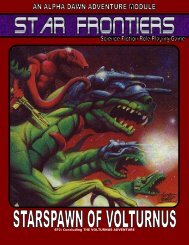Alpha Dawn - Star Frontiersman
Alpha Dawn - Star Frontiersman
Alpha Dawn - Star Frontiersman
Create successful ePaper yourself
Turn your PDF publications into a flip-book with our unique Google optimized e-Paper software.
small, medium, large and giant.<br />
• TINY creatures weigh less than 5 kilograms. They<br />
can be up to 25 centimeters long.<br />
• SMALL creatures weigh from 5 to 20 kilograms and<br />
may be 25 centimeters to 1 meter long.<br />
• MEDIUM creatures weigh from 20 to 200 kilograms<br />
and are between 1 and 3 meters long.<br />
• LARGE creatures weigh from 200 to 1,500 kilograms<br />
and are between 2 and 5 meters long.<br />
• GIANT creatures weigh more than 1,500 kilograms<br />
and are more than 5 meters long.<br />
If the referee wants to create creatures that do not fit<br />
into these general categories, such as parasites, waste<br />
feeders and energy creatures, he should try to answer<br />
the same questions about these creatures that he<br />
would for regular creatures.<br />
4<br />
How Many are Found Together?<br />
The referee should decide whether the creatures<br />
travel alone or in groups. The number in a group<br />
depends on the type of creature and the amount<br />
of food each needs. Large carnivores usually hunt<br />
alone or in small groups, while herbivores tend to<br />
travel in herds for protection. The referee can control<br />
the effect the creatures have in the adventure by<br />
adjusting the number of creatures in a group. A small<br />
carnivore is not much of a challenge, but a pack of 100<br />
small carnivores is.<br />
5<br />
How Fast is the Creature?<br />
The referee must decide how fast a creature is<br />
and how it moves. Movement is a very<br />
important part of combat. Creatures are<br />
specially adapted for maximum speed in their native<br />
terrain and are not affected by terrain movement<br />
modifiers. There are five categories of movement for<br />
creatures: very slow, slow, medium, fast and very fast.<br />
Player characters fit in the slow category.<br />
• VERY SLOW movement is 15 meters/turn or less.<br />
The average very slow speed is 10 meters/turn.<br />
• SLOW movement is 16 to 45 meters/turn. The<br />
average slow speed is 30 meters/turn.<br />
• MEDIUM movement is 16 to 75 meters/turn. The<br />
average medium speed is 60 meters/turn.<br />
• FAST movement is 76 to 105 meters/turn. The<br />
average fast speed is 90 meters/turn.<br />
• VERY FAST movement is more than 105<br />
meters/turn. The average fast speed is 120<br />
meters/turn.<br />
90<br />
The referee should decide how the creature moves and<br />
whether it has any special way to move. For example,<br />
a creature might have wings, fins, a prehensile tail or<br />
many legs, allowing it to fly, swim, swing through trees<br />
or burrow into the ground. The referee also should<br />
note any limits on a creature's movement. For<br />
example, some creatures might spend their entire lives<br />
in one spot, waiting for their prey to come to them.<br />
6<br />
What Are the Creature's Ability Scores?<br />
The referee must choose the creature's ability<br />
scores. Only three of the scores used by<br />
characters are needed for creatures: Stamina,<br />
Reaction Speed and the Initiative modifier. When<br />
selecting ability scores, the referee should be sure they<br />
fit the purpose of the creature.<br />
A good way to determine the scores is to consider how<br />
a similar animal on Earth compares to a Human.<br />
Intelligent alien creatures should be treated as nonplayer<br />
characters. The referee should assign scores for<br />
all eight of their abilities and for any special abilities.<br />
7<br />
How Does the Creature Attack?<br />
The referee should decide how the creature<br />
attacks, what its chance to hit is and how much<br />
damage it causes. If the creature has an<br />
unusual attack, the referee must decide its effects.<br />
When deciding how a creature attacks, the referee<br />
should consider the creature's type and its purpose. In<br />
general, carnivores attack to kill, herbivores attack to<br />
protect themselves and omnivores attack for both<br />
reasons. Carnivores can have claws, teeth, horns and<br />
other offensive weapons. Herbivores are more likely to<br />
have weapons like quills, repulsive odors or horns.<br />
Most creatures can attack only one target, so the<br />
amount of damage a creature causes should be a<br />
combination of all its attacks. The referee should<br />
consider an animal's size, type and purpose in the<br />
adventure when deciding how much damage it causes.<br />
The referee must give the creature a basic chance to<br />
hit, called its Attack score. This value should depend on<br />
the creature's speed, size and purpose, and also on the<br />
abilities of the player characters. A creature's Attack<br />
score should never be greater than 100. If the creature<br />
can attack several targets at once, this number is used<br />
for all attacks.<br />
If the creature has any unusual attacks the referee<br />
should record what their effects and limitations are.<br />
Unusual attacks include poison, acid, shooting darts<br />
and electric shocks. If an attack shoots something, the<br />
referee must assign ranges to the attack.<br />
8<br />
How Does the Creature Defend Itself?<br />
The referee should decide whether the creature<br />
has any defenses and how they affect combat.<br />
Defenses should fit the creature's type and<br />
purpose. Defenses are designed to escape or



